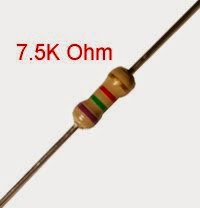"Chapter 3": Circuit Theorems
What is NODAL ANALYSIS?
What is NODAL ANALYSIS?
Nodal analysis provides a general procedure for analyzing circuits using node voltages as the circuit variables. Choosing node voltages instead of element voltages as circuit variables is convenient and reduces the number of equations one must solve simultaneously. To simplify matters, we shall assume in this section that circuits do not contain voltage sources. Circuits that contain voltage sources will be analyzed in the next section.
In nodal analysis, we are interested in finding the node voltages. Given a circuit with "n" nodes without voltage sources, the nodal analysis of the circuit involves taking the following three steps.
"NODAL ANALYSIS W/OUT VOLTAGE SOURCES"
Steps to Determine Node Voltages:
1. Select a node as the reference node. Assign voltages v1,v2,...,vn−1 to the remaining n−1 nodes. The voltages are
referenced with respect to the reference node.
2. Apply KCL to each of the n−1 nonreference nodes. Use Ohm’s law to express the branch currents in terms of node voltages.
3. Solve the resulting simultaneous equations to obtain the unknown node voltages.
Take Note:
- Current flows from a higher potential to a lower potential in a resistor.
We can express this principle as:
i = (Vhigher−Vlower) / R
"NODAL ANALYSIS WITH VOLTAGE SOURCES"
We now consider how voltage sources affect nodal analysis. Consider the following two possibilities.
CASE 1:
If a voltage source is connected between the reference node and a nonreference node, we simply set the voltage at the nonreference node equal to the voltage of the voltage source.
Thus our analysis is somewhat simplified by this knowledge of the voltage at this node.
CASE 2:
If the voltage source (dependent or independent) is connected between two nonreference nodes, the two nonreference nodes form a generalized node or supernode; we apply both KCL and KVL to determine the node voltages.
- A supernode is formed by enclosing a (dependent or independent) voltage source connected between two nonreference nodes and any elements connected in parallel with it.
Note the following
properties of a supernode:
1. The voltage source
inside the supernode provides a constraint equation needed to
solve for the node voltages.
2. A supernode has no
voltage of its own.
3. A supernode
requires the application of both KCL & KVL.
Example:
Example:
First, select a reference node and label the other nodes. Since each node has the same number of connected branches (4), we'll simply choose the bottom node as the reference. There are only two other nodes, which we will label V1 and V2.
Now write KCL at each node (except the reference):
KCL at V1:
-5A + V1/5 + (V1-V2)/10 + [V1-(V2+4)]/10 = 0
Note that there are four terms in the equation, one for each branch leaving the node. The terms list the current leaving right, down, left, and up.
KCL at V2:
(V2-V1)/10 + V2/2 - 2A + [V2-(V1-4)]/10 = 0
Note that there are four terms in the equation, one for each branch leaving the node. The terms list the current leaving right, down, left, and up.
Now gather terms (multiplying through by 10 to clear up the fractions):
4V1 - 2V2 = 54
-2V1 + 7V2 = 16
Now solve the set of 2 equations with 2 unknowns.
V1 = 17.08V
V2 = 7.17V
We can now determine the current through the 5 ohm by Ohm's law:
I = V1/5 = 3.41A
The current through the 4V source can be found as:
I = [V1-(V2+4)]/10 = 0.59A

Some Insights:
- The knowledge in KCL & KVL are very important to undergo with the Nodal Analysis.
- We can assign one reference and non-reference nodes anywhere we want in a given number of nodes.
- Shortcut method in getting the equations can executed in the circuit with or without supernodes.
Video:
For more information, you can watch the video below:
Enjoy watching!
That's all. Thank You for visiting my blog.
GOD Bless! :)
By:
AYALA, ARNY S. BSECE -3
ECE 311
Professor:
ENGR. JAY S. VILLAN, MEP














